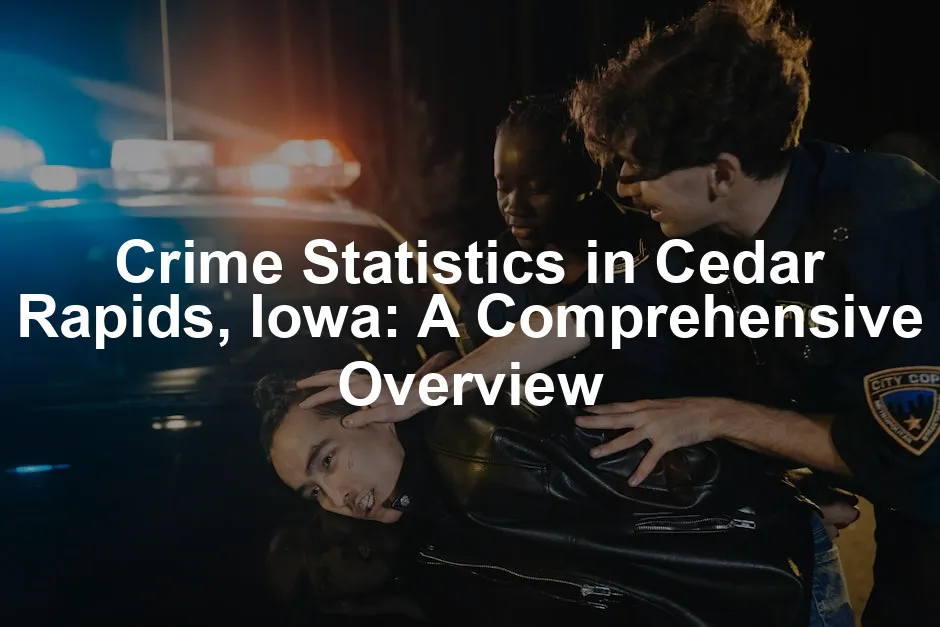Introduction
Cedar Rapids, Iowa, is often affectionately known as the “City of Five Seasons.” This charming city, nestled along the banks of the Cedar River, is the second-largest in Iowa. It boasts a rich history tied to agriculture, manufacturing, and the arts. Beyond its picturesque landscapes, understanding the crime statistics in Cedar Rapids is essential for both current residents and those considering moving here.
Why should you care about crime statistics? For starters, they provide a clearer picture of safety and security within the community. Crime rates help residents gauge their vulnerability and empower potential movers to make informed decisions about where to plant their roots. Whether you’re a long-time resident or a newcomer, knowing the local crime trends can help protect you and your loved ones.
Data from reliable sources, such as the FBI, local police reports, and community surveys, will paint a vivid picture of the crime landscape in Cedar Rapids. By examining these statistics, we can better understand the challenges faced by this vibrant city and highlight areas of improvement. In this article, we’ll delve into various aspects of crime statistics, ensuring that you leave with a comprehensive view of Cedar Rapids’ safety dynamics.

Now that we’ve set the stage, let’s jump into the nitty-gritty and explore the current crime rates in Cedar Rapids. After all, knowledge is power, and when it comes to safety, you can never be too informed. While you’re at it, consider enhancing your home security with a Home Security Camera System. It’s a smart way to keep an eye on things while you sleep soundly at night!
Crime Rate Overview
Current Crime Rate Statistics
As of the latest report, Cedar Rapids has an overall crime rate of 34 per 1,000 residents. This alarming figure is noteworthy, especially considering that over 98% of communities in Iowa report lower crime rates. With a chance of victimization at 1 in 30, it’s clear that safety concerns are present.
When we break down the numbers, we see that the violent crime rate stands at 3.2 per 1,000 residents. This translates to a 1 in 312 chance of becoming a victim of violent crime. To put this in perspective, the national average for violent crime is significantly higher, making Cedar Rapids a relatively safer option than many urban areas.
Property crime is where Cedar Rapids really stands out, though not in the best way. The property crime rate is a staggering 30.37 per 1,000 residents, which means residents face a 1 in 33 chance of experiencing a property crime. This includes incidents such as burglary, theft, and motor vehicle theft. In fact, Cedar Rapids has one of the highest rates of motor vehicle theft in the nation, with a 1 in 326 chance of having a vehicle stolen.

To tackle these concerns, you might want to consider investing in a Smart Door Lock. Imagine being able to unlock your door with just a tap on your phone—no more fumbling for keys while carrying groceries!
Data for these statistics is sourced from the FBI’s Uniform Crime Reports, which compile information from over 18,000 local law enforcement agencies across the United States. This comprehensive dataset allows for accurate comparisons between Cedar Rapids and both state and national averages.
It’s essential to keep these numbers in context. While crime exists in Cedar Rapids, understanding the trends and statistics can help residents and potential movers make informed decisions about their safety and well-being. As we continue, we’ll examine historical crime trends and delve deeper into specific categories, such as violent and property crimes, to uncover the full picture of safety in Cedar Rapids.
Historical Context
Cedar Rapids has seen a rollercoaster of crime rates over the years. If only the numbers could tell jokes! Nevertheless, they paint a telling story. The overall crime rate in Cedar Rapids has fluctuated, with significant peaks and valleys that reflect the city’s dynamic nature.
In recent history, the crime rate rose sharply in the early 2000s, peaking around 2014. Since then, a slow decline has been observed. This change isn’t a simple coincidence; it correlates with several key events. For instance, the city’s proactive initiatives in community policing and crime prevention programs have started to show their fruits.
The 2020 pandemic also played a role. During lockdowns, some crimes decreased, while others, especially domestic violence incidents, surged. This duality in crime patterns made it evident that external factors heavily influence crime statistics.

Notably, in 2023, the Cedar Rapids Police Department reported a decrease in violent crimes, like assault and robbery, compared to the previous year. This was attributed to heightened police presence and community engagement efforts. It’s almost like a neighborhood watch on steroids, working to foster safer streets.
In light of these statistics, consider keeping a Personal Safety Alarm handy. It’s a small device that can make a big difference in alerting others in case of an emergency!
So, what does all this mean? The crime statistics in Cedar Rapids are not just numbers; they reflect the community’s resilience and ongoing efforts to improve safety. With collective resolve, the city can continue to shape its crime trends positively.
Violent Crime Statistics
Types of Violent Crimes
When it comes to violent crime in Cedar Rapids, the statistics reveal a mixed bag of incidents that can send shivers down your spine. Let’s break it down, shall we?
- Murder: In 2022, Cedar Rapids recorded 10 murders. That’s a stark number, especially when you compare it to the national average, which hovers around 6.3 per 100,000 residents. Here, the murder rate is slightly higher than the national average, sparking conversations about safety.
- Rape: Cedar Rapids reported 14 incidents of rape in 2022. The national average stands at about 40.7, making Cedar Rapids appear relatively safe in this category. Still, any number of sexual violence is too many and deserves our attention.
- Robbery: With 55 robberies reported, Cedar Rapids shows a rate lower than the national average of 135.5. This indicates that while some areas of the city might feel a bit edgy, others are doing just fine in terms of robbery prevention.
- Assault: Assault incidents are the heavyweight champion here, with 358 reported cases. This translates to a violent crime rate of 3.2 per 1,000 residents. Nationally, the average is around 282.7 per 100,000. It seems Cedar Rapids might need to work on its punching bag game!

When you mesh these statistics together, you get a vivid picture of the violent crime landscape in Cedar Rapids. Although the murder and rape rates are concerning, the overall violent crime rate is lower than the national average, suggesting that the city has its share of challenges, but there’s also room for optimism.
In the grand scheme of things, these numbers give residents an overview of what’s happening in their neighborhoods. Understanding the types and prevalence of violent crimes can help community members work together to improve safety and support one another. Knowledge is indeed power, especially in the realm of safety and security.

If you’re looking to bolster your personal safety, consider carrying a Pepper Spray. It’s a handy tool that can help you feel more secure when walking alone at night!
Year-over-Year Changes
Cedar Rapids has experienced interesting shifts in its violent crime rates over recent years. Notably, there was a significant decrease in violent crimes in 2023 compared to 2022. Specifically, the overall violent crime rate fell by approximately 6%. This drop included reductions in key areas such as assault and robbery, showcasing a positive trend for community safety.
But what sparked these changes? The Cedar Rapids Police Department attributes much of this decline to proactive law enforcement initiatives. For instance, increased police visibility and community policing efforts have played a significant role. Officers on the beat are not just there to serve and protect; they’re also engaging with residents to build trust. When people know their officers, they feel safer and more likely to report suspicious activities.
Community programs aimed at violence prevention have also made a mark. Initiatives that focus on youth engagement and education have fostered a sense of community and purpose. Programs like mentorship opportunities and after-school activities have kept kids off the streets and away from crime. It’s like turning the tide; instead of waiting for trouble, the community is stepping up to prevent it.
However, it’s essential to remember that these gains can be fragile. The interplay of social factors, such as economic conditions and drug issues, remains a concern. The interim police chief highlighted ongoing issues with methamphetamine and fentanyl in the area. Such challenges can easily reverse progress if left unaddressed.
In summary, Cedar Rapids is witnessing positive changes in violent crime rates, thanks to effective law enforcement strategies and community programs. But maintaining this momentum requires continuous effort and vigilance from both the police and community members.
Property Crime Statistics
Types of Property Crimes
When we look at property crime in Cedar Rapids, the statistics reveal a more complex picture. This category primarily includes burglary, theft, and motor vehicle theft, each contributing significantly to the overall crime landscape.
- Burglary: In 2022, Cedar Rapids recorded 611 burglary incidents. This figure gives residents a 1 in 164 chance of experiencing a burglary. Comparatively, the national average for burglary stands at around 500.1 per 100,000 residents, making Cedar Rapids’ rate higher than the average.
- Theft: Larceny theft is where Cedar Rapids really stands out—3,113 thefts were reported in 2022! This staggering number translates to a property crime rate of 30.37 per 1,000 residents. For context, the national average is significantly lower at 2,042.8 per 100,000 residents. With a chance of 1 in 33 of becoming a theft victim, it’s clear that residents must remain vigilant.
- Motor Vehicle Theft: Cedar Rapids has one of the highest rates of motor vehicle theft in the nation, with 419 incidents reported last year. This translates to a 1 in 326 chance of having your vehicle stolen. Nationally, the average for motor vehicle theft is around 284 per 100,000 residents—again, indicating Cedar Rapids is above average in this regard.

Comparing Cedar Rapids to national averages provides essential context. While the city enjoys a relatively lower violent crime rate, property crimes present a different challenge. The prevalence of theft and burglary highlights the need for improved security measures and community awareness.
So, what’s contributing to these high property crime rates? Several factors play a role. Economic challenges, such as unemployment and poverty, often correlate with increased crime. Cedar Rapids is not immune to these issues, and they can exacerbate property crime rates. The interplay of these socioeconomic factors can create a breeding ground for crime if left unchecked.
To combat these trends, local law enforcement has ramped up their efforts. Community outreach programs aim to educate residents about crime prevention techniques, encouraging them to take proactive measures in securing their homes and vehicles. Simple acts like neighborhood watch programs and community safety meetings can foster a collective sense of responsibility.
In conclusion, while Cedar Rapids shows promise in reducing violent crimes, property crime remains a pressing concern. By addressing the root causes and empowering the community, residents can work together to combat these statistics and enhance safety. The challenge lies ahead, but with community collaboration, a safer Cedar Rapids is within reach.

Consider equipping your home with a Fire Extinguisher. You never know when a small flame can turn into a big problem, and being prepared is always better than being sorry!
Analysis of Property Crime Trends
Cedar Rapids faces notable property crime challenges. With a property crime rate of 30.37 per 1,000 residents, the implications for community safety are significant. Residents experience a 1 in 33 chance of being a victim of property crime, which can lead to feelings of insecurity and anxiety. High property crime rates can erode trust in neighborhoods and deter community engagement.
Understanding specific neighborhood trends is vital. Areas like downtown Cedar Rapids and some parts of the northeast have been identified as hotspots for property crimes. These neighborhoods often contend with socioeconomic issues, which can exacerbate crime rates. Residents in these areas may face constant vigilance, impacting their quality of life.
Conversely, neighborhoods with lower crime rates often have stronger community ties and active engagement with local law enforcement. This reinforces the idea that community involvement can play a crucial role in curbing crime.
Neighborhood Safety Insights
Safest Neighborhoods
Cedar Rapids has several neighborhoods that are considered safe havens for residents. Notable among them are Bowman Woods Park, Fox Tail Park, and Blairs Ferry Rd / Milburn Rd. These areas boast lower crime rates, offering a sense of security to their inhabitants.
What makes these neighborhoods stand out? Community programs and a visible police presence contribute to the overall safety. For example, Bowman Woods Park has organized neighborhood watch groups that foster communication among residents. This proactive approach creates a supportive environment, making it harder for crime to take root.
Moreover, local events and activities encourage residents to connect. This sense of community serves as a deterrent to potential criminals. When neighborhoods are vibrant and engaged, it signals that residents care about their surroundings, making them less attractive targets for crime.

Police engagement is also a significant factor. In safer neighborhoods, officers often participate in community events, helping to build trust and ensuring residents feel comfortable reporting suspicious activities. This partnership between residents and law enforcement is key to maintaining safety.
In summary, Cedar Rapids has safe neighborhoods where community involvement and police presence create a protective atmosphere. By nurturing these positive dynamics, residents can enjoy their surroundings while working together to keep crime at bay.
Law Enforcement and Community Response
Police Department Overview
The Cedar Rapids Police Department (CRPD) stands as a vigilant protector of the city. With approximately 263 officers, it operates with a structure designed for efficiency. The department is organized into various divisions, including patrol, investigations, and community services. This allows the department to respond effectively to crime and maintain public safety.
To combat crime, the CRPD employs several strategies. One of the main approaches is community policing. Officers engage with residents to build trust and open lines of communication. This presence fosters a sense of security and encourages community members to report suspicious activities.
Additionally, the department utilizes data-driven tactics. By analyzing crime patterns, they can allocate resources to high-crime areas more effectively. This proactive approach not only addresses current issues but also aims to prevent future incidents. Programs like “Operation Safe Streets” focus on reducing crime through collaborative efforts between law enforcement and community organizations.

Moreover, the department embraces technology. They utilize crime mapping tools to visualize crime hotspots, allowing officers to strategize deployments. This tech-savvy approach enhances their capability to respond promptly to emerging threats.
Community Engagement
Community engagement plays a crucial role in enhancing safety in Cedar Rapids. Numerous programs aim to reduce crime rates and foster a sense of belonging among residents. Initiatives like neighborhood watch groups empower citizens to take an active role in their safety. These groups promote vigilance and communication, making neighborhoods less inviting for potential criminals.
Local organizations also contribute significantly to crime prevention. Partnerships with schools, churches, and non-profits provide resources and support for various community initiatives. For instance, youth programs focus on mentorship and education, steering young people away from crime and into positive activities.
Community leaders also have a hand in promoting safety. They often collaborate with law enforcement to address local concerns, ensuring that residents’ voices are heard. Regular community meetings provide platforms for discussing safety issues and developing strategies to tackle them.
Additionally, the CRPD organizes events like “National Night Out,” which enhances community-police relations. These events encourage residents to come together, socialize, and learn about safety resources. The camaraderie fosters a strong community spirit, making Cedar Rapids a safer place for everyone.

Through these combined efforts, Cedar Rapids demonstrates a commitment to improving safety. The collaboration between law enforcement and the community creates a resilient environment, ultimately reducing crime and enhancing quality of life.
Year 2023 Updates and Trends
2023 Crime Statistics
Recent statistics from 2023 indicate a promising shift in Cedar Rapids’ crime landscape. Overall crime rates saw a decline, with a notable reduction in violent crimes. Reports show that violent crime decreased by approximately 6% compared to 2022. Specifically, incidents of rape, assault, and murder also dropped, showcasing the effectiveness of ongoing law enforcement strategies.
For property crimes, the statistics are equally encouraging. Property crime decreased by 5%, with significant reductions in robbery and burglary. For instance, robbery rates fell by 28%, while burglaries decreased by 20%. However, it’s worth mentioning that shoplifting incidents increased by 17%, indicating a shift in the crime landscape that law enforcement must address moving forward.
The data also highlights that Cedar Rapids remains a challenging environment for certain property crimes. Motor vehicle theft continues to be a pressing concern, despite overall improvements. With a chance of 1 in 326 of having a vehicle stolen, residents are reminded to take precautionary measures. A good start would be to invest in a reliable Bicycle Lock to secure your ride!

Future Outlook
Looking ahead, Cedar Rapids appears poised for further improvements in community safety. The proactive initiatives currently in place, combined with community engagement efforts, suggest a continued downward trend in crime rates. As local organizations and law enforcement collaborate, the effectiveness of these strategies should only increase.
Additionally, the city is focusing on addressing underlying socioeconomic issues that contribute to crime. By investing in community programs and educational initiatives, Cedar Rapids aims to create opportunities for residents, ultimately reducing the factors that lead to criminal activity.
However, challenges remain. The ongoing drug crisis, particularly related to methamphetamine and fentanyl, poses a significant hurdle. As these substances continue to impact the community, law enforcement must adapt strategies to combat drug-related crimes effectively.
In summary, the future of crime in Cedar Rapids looks hopeful. With continued collaboration between law enforcement, community organizations, and residents, the city can work towards a safer environment for all. Residents are encouraged to stay informed and engaged in crime prevention efforts, ensuring Cedar Rapids remains a vibrant and secure place to call home. And don’t forget to grab an Emergency Preparedness Kit—you never know when you might need it!
Understanding crime statistics is crucial for residents and potential movers in Cedar Rapids. Learn more about crime statistics in various regions.
Please let us know what you think about our content by leaving a comment down below!
Thank you for reading till here 🙂
All images from Pexels




